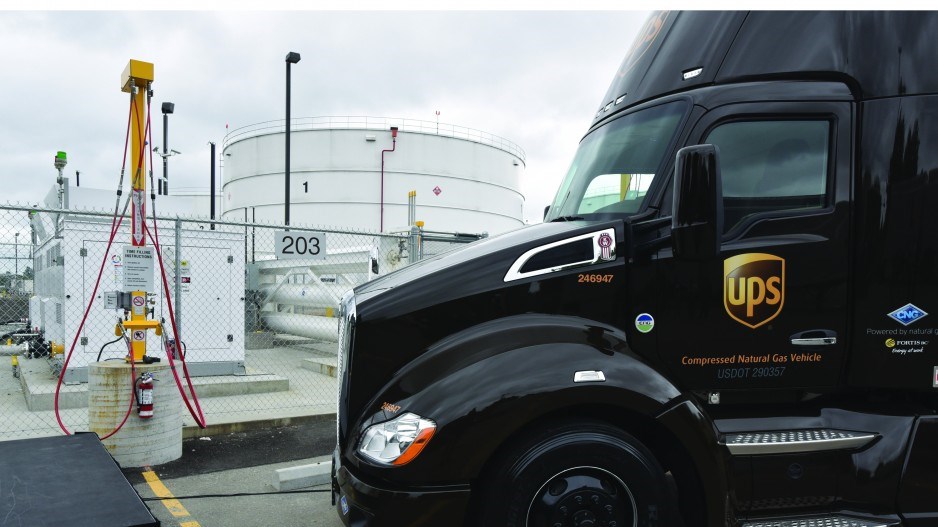Owners of trucking fleets waiting to switch their fleets from diesel to natural gas may want to pay attention to diesel prices in the coming months.
According to the petroleum intelligence firm Kent Group Ltd., Canadians can expect to see diesel prices rise by $0.05 to $0.10 per litre.
New International Maritime Organization caps on sulphur emissions that take effect in 2020 are already prompting international shipping companies to switch their ships from burning bunker fuel to diesel.
That will have a domino effect on refining throughout North America, Kent Group predicts, with coastal markets likely experiencing the greatest diesel price increases.
That could be good for Burnaby-based Westport Fuel Systems (TSX:WPRT) and its joint venture, Cummins Westport Inc., which make natural gas engines for medium- and heavy-duty trucks.
The company may also get a boost from Natural Resources Canada (NRCan), which recently published a road map for accelerating the conversion to natural gas in Canada’s medium- and heavy-duty transportation sector, which accounts for 25% of the country’s carbon dioxide (CO2) emissions.
Westport could use the boost. Since it was spun out of the University of British Columbia (UBC) as Westport Innovations, the company has struggled to generate profits.
The expected switch from diesel to natural gas in the heavy trucking sector has been delayed in North America in part due to the energy boom in the U.S., which has kept diesel prices down south relatively low.
The company has also spent an enormous amount of money on research and development, especially on its latest heavy-duty truck engine.
“Getting profitable has been really a challenge because it’s taken a huge amount of money to invest to develop particularly this heavy-duty technology,” said Jim Arthurs, executive vice-president, electronics, Westport Fuel Systems. “We’ve spent $1 billion of R&D money since inception. But we now have launched that technology and now that product is selling.
“So we are on a growth path now because this technology is launching and ramping up. And we are moving towards profitability very steadily.”
As a startup spun out of UBC in 1994, Westport Innovations developed technology that allowed natural gas to be injected into conventional diesel engines.
It has grown over the years through a series of strategic partnerships and joint ventures, including with Cummins Inc. (NYSE:CMI) – Cummins Westport – and China’s Weichai Power Co. Ltd. (SHE:000338).
Three years ago, Westport merged with Fuel Systems Inc. to form Westport Fuel Systems.
Burnaby remains the company’s headquarters and its engineering centre. It has a number of manufacturing divisions outside of Canada, with a global head count of about 1,200 and a market cap of $452 million. The Cummins Westport joint venture alone is a $320 million business, focused primarily on making natural gas engines for medium-duty trucks.
Westport also works with original equipment manufacturers, like Volvo AB (STO:VOLV-B), to supply heavy-duty engines.
Originally, converting to natural gas was more about reducing air pollution since natural gas burns more cleanly than diesel. But it’s also now seen as a way of reducing greenhouse gases (GHGs) in the transportation sector.
Switching from diesel to natural gas can result in CO2 emission reductions of 21% to 30%, according to Natural Gas Use in the Canadian Transportation Sector – NRCan’s new road map.
“For example, if one out of every 10 new medium- and heavy-duty vehicles sold in Canada over the next 10 years were natural gas-powered (36,000 vehicles), carbon emissions could be reduced by an estimated 1.99 megatonnes annually by 2020,” the road map states.
There are currently 800 medium- and heavy-duty trucks running on compressed natural gas or liquefied natural gas in B.C.
Canada-wide, close to 400 heavy-duty vehicles fuelled by natural gas were added in 2015 and more than 300 in 2016, according to the report. Most of those trucks use Cummins Westport engines.
Compared with Asia and Europe, however, the switch to natural gas in Canada and the U.S has been slow, Arthurs said. Of the 280,000 heavy-duty trucks sold in North America last year, only 7,500 were natural gas vehicles.
“In the heavy-duty market in North America, the penetration is really quite low,” he said. “Transit buses were well penetrated. About a third of the transit buses are natural gas and over half of the garbage trucks. But in the long-haul [sector], it’s still pretty sparse. We sell a lot more systems outside North America than in North America.”
One of the barriers to adoption is simply cost. Natural gas systems are $40,000 to $80,000 more expensive than their diesel counterparts, with the extra costs coming mainly from fuel tanks.
Diesel prices are also still comparatively low in North America, and the price differential between diesel and natural gas has to be significant enough to justify extra upfront capital costs for fleets to switch.
“You need fuel stations, you need the fuel prices to be right, you need the right tax policy,” Arthurs said.
Westport is focused on Europe as a growing market thanks to new regulations – which come with penalties – that will require transportation fleets to reduce CO2 emissions by 15% by 2025, and 30% by 2030.
One way to get to 30% or beyond is by using renewable natural gas (RNG), which is made from landfill gas, sewage treatment plants, and wood and agricultural waste. RNG is a sector focused on in NRCan’s road map, and one FortisBC is keen to develop.
“Modelling indicates that substituting 5% of natural gas used in Canada with RNG can eliminate 14 [megatonnes] of GHGs by 2030,” the NRCan road map states.
“The technology that we’ve launched in Europe provides a 20% CO2 reduction, so the trucks that have our technology today are already good through 2029,” Arthurs said. “And with a little additional work, hopefully we’ll be able to meet the 2030 standards as well.”




